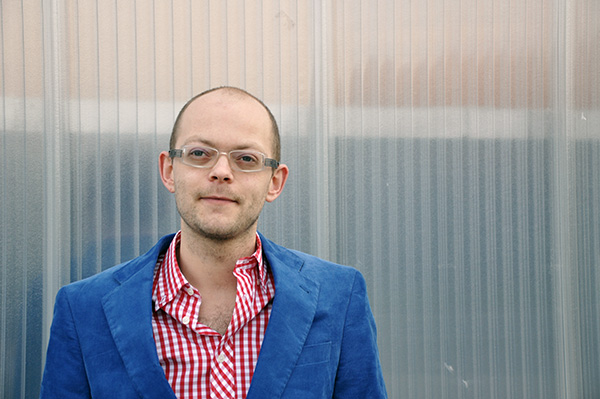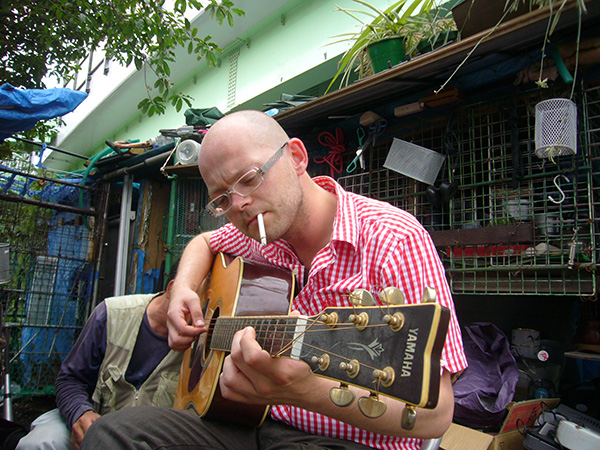

Max-Phillip Aschenbrenner(Dramaturg)
“The biggest distance you can have to a spot on earth is the moment you leave it, because every step you take from there brings you closer to it again” romances Victor Segalen, french writer and philosopher in 1903 a.d. when he was travelling East Asia and Polynesia. He can be considered to be the first European, whose aim was to experience the other without becoming a “pimp of exotism”. A small but important difference, that gets lost in the translation of this quote is, that the german term ‘erfahren’ not only means ‘experience’, but in a very litteral way ‘moving around’.

Max-Phillip Aschenbrenner
“Kappa” Moments
Even though I had already seen some contemporary japanese stage and visual arts and collaborated with different artists from the country in my professional work as a programmer, my strongest perceptive memories before my residency at Morishita Studio in July 2012 were linked to a 6 week travel from the very South of Okinawa to the northern borders of Hokkaido in 2004.
I still remember this one day clearly: I was doing the groceries in Tono, when I heared somebody shout: “He, he, you must be european, can we talk for a while”, ending in a 4 hour trip in a private car with a former BBC journalist, who had just moved tot he countryside with her husband. The tricky part of this unplanned meeting was, that – after reading all the folk tales coming from this region as a preparation for my trip – when we we’re standing in a Shinto shrine in front of a huge stone resembling a phallus my mind going crazy. I was sure I was the clear target of a Kapa now and my life would end every moment.
Why do I tell this personal story? It may give an idea about, what I experienced again during my recent research: You can only embrace the unknow other. When travelling professionally there is usually always a reason or a taks like watching a specific show, attending meetings or a festival; But having the luxury to just live a bit in Tokyo, meet the people I wanted to meet, following my own schedule, really made me re-think my profession. It’s not about the stupid idea of getting an overview or a taste of a culture or an artistic scene, it’s all about choices: About not having a rushed dinnermeeting between two shows, but having three lunches with an interessting person, of not trying to find the most suitable ‘object’ for a specific purpose – festival, showcase, collaboration, but simply wasting time with artists, activists, interessting people.
The team of Saison foundation was very supportive in helping me find the right persons to talk to, translating when necessary, giving a helping hand, whenever I needed one. I never felt alone, never lost and on the other hand never observed. What they are creating at Morishita studio is a little kingdom of magic. The place provided is fantastic and has everything you need and it’s perfectly located: Not in one of the fancy areas like Shibuya, Shinjuku or Ikebukuro. It’s not that I don’t like these quaters, but they tempt you much more to believe your typical clichees. One drop of bitterness was, that I did not really connect with my two roommates. But the mix was super smart, I still have the sound of the Gayageum played next door in my ears.
The travelling wihtin the big travel to Japan is a another fantastic thing Saison foundation is providing. Not only my bigger trips to Kyoto, watching some contemporary Kyogen or to Osaka and the visit of a nearly private opening of an exhibition there with fabulous Yuya Tsukahara, but also the short trips within the city to meet at private houses, spots you’d never get to know your own. One night, the fabulous director Tanino Kuro was taking me on a ride through Tokyo in his car, we stopped at Tokyo bay, standing in front of some big sings created by candels. Nobody could explain their meaning, I had another Kapa moment, this time not of fear but of experiencing pure warmth and beauty.
Living in a state of permanent crisis
My aim for my research was to create moments, in which it becomes irrelevant, where one or the other is from, what he does or does not, how the relation is formed by economical, financial, social needs, but to spend time together. The arts sector is so fast in finding terms, descpriptions, pictures for works or people, and tends to reduce artists to representatives of their work, or even worse cultures. Since I started working in this field, I was always interessted in eliminating this layer. My residency time gave me a taste of this and I’m still sad, that I could not take more time, as I had just started my new job, directing an arts and cultural centre in Switzerland.
Focussing on young artists and thinkers, that deal with their critical view on society and who are not afraid of also being critical with their view on their aesthetics, I rediscovered another read thread in my research. Having arrived just a few months after 3.11, society and the role of a cityoen in society was a topic on the table everywhere. Nobody talked about the elements, their power and the result of their power, but about the relation of a human being towards them. I realized, that Japan consideres itself to live in a situation of crisis, not in an economical crisis after the burst of the bubble or in a nuclear crisis after 3.11, but a permanent crisis in the very old sense of the term. The ancient greek word κρίσις krísis stands for opinion, estimation and consequently also for decision.
And this is, where I personally, but also the west should learn from Japan: The state of permanently deciding makes you a much calmer, more grateful and caring person.
I really hope to give back some of these feelings, when the first collaborations resulting from this trip will happen at SÜDPOL, the space I am running in the small mountain village Lucerne in Switzerland. Noriyuki Kiguchi from Akumanoshirushi will sped some days here and develops his carry-in-project with students from the technical high school, into a carry-in-sculpture wandering through the three swiss cities of Zurich, Basel and Lucerne. His work questions the relation of art and society in a big sense, and the relation of the artist and the audience in the sense of the concrete moment in a very smart way. It makes everybody, who is part of this experience realize how important your own directions ans thoughts are for a so-called abstract society, how concrete it is to be a responsible person for world wide decisions.
Who needs art centers?
Whereas in Europe, especially in the german speaking cultures, we face the big challenge, that the top-down arts like opera, ballet or fine arts and the bottom up arts like theatre, art in public space or ‘digital’/’virtual’ arts just won’t come together, the handling of forms in Japan is a lot more playful. Not playful in a sense of not being honest with a tradition or a classical form, but playful in a sense of being open towards different directions a spcific decision might take you. In Europe the old elites get more and more conservative again, they bring up new borders and try to conserve even more, then a few years ago, when the economical situation was a lot better. Even though fresh decisions and directions might eventually take the West somewhere else interessting.
Next to my building is an informal settlement of about 30 wannabe dropouts living in trailers, tents and home made wooden structures. Their philosphy is dating back to the 60ies, refusing society as a given structure to live in, trying to question it. I should mention at this point, that they use the facilities of our house and draw their electrical power from SÜDPOL. Kyohei Sakaguchi will work with them in summer: Talk, discuss, create ideas. His approach of a Zero Yen society doesn’t romantisize such questions as: “How do you want to live and what do you need for it?”, but takes them to a contemporary dimension. When he told me about his thought, that in about fifty years about fifty percent of all housing space will be empty, because society is extincting itself through getting older and older, i realised, that the children of the guys next door might find it a lot easier to live in this room here, where I am sitting right now, writing this lines: “Who will need arts centers then and what will they look like?”

Research session with Kyohei Sakaguchi, architect
Max-Philip Aschenbrenner
Born in Deggendorf, Germany in 1981. Aschenbrenner has working experiences as an artistic director (Luzern, SÜDPOL) and a dramaturg. He studied media studies, interaction and process designs, and thereafter earned a master’s degree in dramturgy. He took the position of the dramaturg for HAU (Hebbel Theater, Berlin) in 2008, “Loan Shark” directed by Chris Kondek at Rotterdamse Schouwburg, and “King Lear” directed by Barbara Weber at Wiener Festwochen (Vienna Festival) and HAU. Aschenbrenner worked with Frie Leysen as the artistic collaborator for “Theater der Welt 2010” from 2009 to 2010, and as the artistic coordinator for an art project supported by Deutsche Bank “A Globe for Frankfurt and the World”. He was invited to Japan by the Japan Foundation in November 2011. Aschenbrenner visited Japan again in 2011 as the visiting fellow of the Saison Foundation.
—
Words of Recommendation
Taro Inamura (Program Coordinator, The Saison Foundation)
The Saison Foundation started a residency program, “Visiting Fellows, Residence-in-Morishita,” in 2011, aiming at expansion of the international network of contemporary theater and dance and promotion of mutual understanding among people in the field. Unlike conventional Artist-in-Residence programs for artists, this program is for art administrators active in other countries, including presenters, program directors and curators in the field of performing arts, to give them opportunities to understand the current situation and attractiveness of Japanese contemporary theater and dance.
In July 2011, we invited Mr. Max-Phillip Aschenbrenner as one of the first Visiting Fellows. He was active as a freelance dramaturg in Germany before being assigned as a co-curator of the World Theater Festival organized by the German Center of the International Theater Institute. He is a promising art administrator who was appointed as the artistic director of SÜDPOL in Luzern, Switzerland last year at the age of just 30. Under the theme “Labelling – how we do describe international arts,” he keeps his unique perspective without adhering to the genre of performing arts. Through our foundation’s program he has contributed to deepening exchanges among artists and other professionals in the fields of theater, art and architecture, as well as people active beyond the borders of these fields, in order to expand the network of Japanese performing arts. We held his public talk session to hear the status quo of performing arts in the German-speaking sphere in Europe during his stay in Japan. He has been assigned as artistic director of SÜDPOL at a time when public theaters in Europe are forced to cut their budgets significantly as a result of government austerity policies. Based on this experience under such difficult circumstances, he presented ideas on how to create novel performing arts. With participants’ positive contributions to the discussion, this session provided us with an opportunity to think about the future of performing arts from a global viewpoint.
Our foundation’s Visiting Fellows program focuses support for encounters that can promote exchanges between Japan and the rest of the world. Making the best use of the foundation’s network, we arrange the fellows’ schedules, including their stay, interviews and meetings during their residency in Japan according to their requests on the content of their research, in consultation with them. Therefore, what each fellow does in the program is different. In the Morishita Studio, the base of the fellows’ residencies, open rehearsals, shows, workshops, symposiums and other activities of contemporary drama and dance regularly take place, providing fellows with a very stimulating experience in an environment where artists and others involved in Japanese contemporary drama and dance gather.
In 2012, we are planning to invite Visiting Fellows with diverse backgrounds from Europe, North America, the Middle East and Asia. We will continue to contribute to promotion of Japanese performing arts as the foundation of the network between Japan and other countries.
[March 31, 2012]
Reference:
AIR_J>SEARCH>The Saison Foundation Artist-in-Residence
2024.7.9Acasă la Hundorf Residency JournalArtist : Miyake Suzuko
2023.5.14AIR and I, 09 : Mentoring Artists for Women’s Art (MAWA) Residence Report